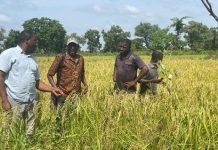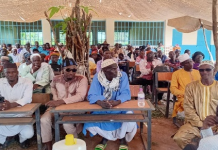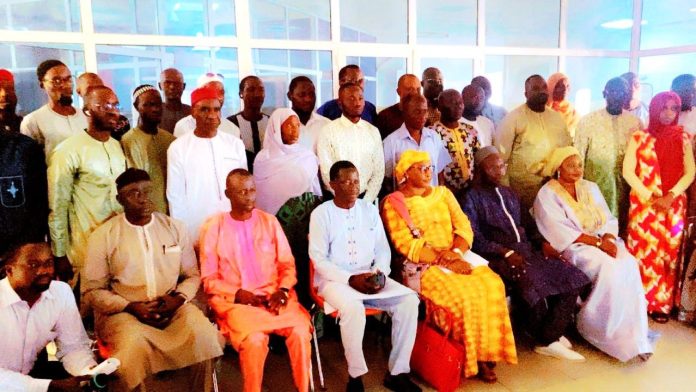By Biran Gaye
Experts have projected that Gambia is likely to receive between 700mm and 900mm of rainfall – a substantial amount essential for agricultural production as farmers clear their farmlands ahead of the 2025 season.
This forecast, announced by the Department of Water Resources through the Ministry of Water Resources, Fisheries and National Assembly Matters on Friday, May 16 at a seasonal rainfall prediction forum held at the NaNA conference, indicates a potential increase in precipitation compared to previous years.
This year’s seasonal rainfall is expected to be between normal to above normal level across the country, with the rainy season predicted to be late to normal in most areas.
Upper River Region and Central River Region are expected to receive first rains between 12 and 19 June while the other parts of the country are expected to receive first rains between 20 and 25 June, according to the forecast.
The rainy season is expected to end between 20 and 26 October, 2025, which experts consider ‘late to normal’.
Such rainfall levels can have profound implications for agriculture, water supply, and local ecosystems.
Director of Water Resources Lamin Mai Touray said farmers may benefit from this expected rainfall, as adequate precipitation is crucial for crop growth and can lead to improved yields.
“This forecast is a crucial tool for informed decision-making,” said Director Touray. “The effects can be far reaching for food security.”
The distribution and timing of rainfall play a critical role in agricultural outcomes.
“It allows farmers, planners, responders, and communities to prepare for the months ahead,” he noted. “But to be effective, the message must reach every household -and that is where the media plays a central role.”
He acknowledges the projected rainfall amounts will also affect water resources and management throughout the country.
Excessive rainfall can result in flooding, whereas inadequate rainfall may adversely affect agricultural productivity.
Project coordinator of Rural Integrated Climate Adaptation Resilience Building Project (RICAR) Aji Oulaye Njie said sub-Saharan Africa remains largely vulnerable to climatic variability that influences rainfall patterns and crop production.
“Timely actionable forecasts are not only mere scientific outputs but are lifeline for farmers selecting crop varieties, pastoral grazing, and policy makers to design disaster risk mitigation,” she underscored.
She reiterated their commitment to supporting crop production and climate resilience.
Communities that rely on rainfall for irrigation may find relief in the anticipated increased moisture, with experts warning of the challenges that come with heavy rainfall, such as soil erosion and waterlogging.
Deputy Permanent Secretary, Ministry of Water Resources and Fisheries, Fanta Bojang Samateh Manneh, said the sub-region remains one of the most vulnerable to the effects of climate change.
“Due to the largely economic dependence on natural resources in our context, the characteristics of rainy seasons, its onset, distribution, cessation and the frequency of dry spells are crucial determinants of agricultural productivity and water availability,” she stated.
These variations, DPS Bojang Samateh Manneh highlighted, significantly impact agro-pastoral systems, food and nutritional security and also increase the frequency and severity of extreme events such as floods and droughts in recent years.
“The combined pressures of environmental change, population growth and increased climate vulnerability have highlighted risk to our agricultural system, intensifying the risk of natural disasters,” she said.
DPS Bojng Samateh Manneh renews the government’s commitment to reducing poverty and building resilience through climate services and risk reduction mechanisms.
Gambia’s environmental and economic stakeholders will need to closely monitor these projections and develop strategies to maximise the benefits while mitigating potential risks associated with the forecasted rainfall. Proper planning and investment in infrastructure could help the country adapt to the anticipated weather patterns, ensuring a sustainable and productive future for its residents.
Dry Spells
Short dry spells are anticipated at the beginning and end of the rainy season.
Chief meteorologist Peter Gibba advised farmers to diversify agricultural practices as well as grow drought resistant varieties that can withstand dry conditions as well as rotate crops annually to improve soil fertility and reduce pest populations.
“Farmers are equally advised to grow late maturing crops at the onset of the rainy season to ensure high productivity,” he told Foroyaa. “Let’s us ensure that climate information transmits into early action.”
During dry spells, experts also recommended several strategies for farmers in the Upper River Region, including soil conservation techniques like mulching and the use of cover crops to retain soil moisture and improve soil health, as well as water conservation practices such as rainwater harvesting, constructing small dams, or using drip irrigation systems. This can help ensure a steady water supply during dry periods.
Farmers are urged to adjust planting schedules to align with seasonal weather patterns, taking advantage of any available rainfall.
They also called for sustainable farming practices and climate adaptation strategies.
By adopting these strategies, farmers in the Upper River Region can improve their resilience to dry spells and minimise negative impacts on their livelihoods.
















